What Is Aircraft Asset Management and Why Does It Matter to Lessors
bc
Using real-time aviation data and ADS-B networks helps aircraft lessors track fleet activity. This reduces credit risk and increases asset value throughout the aircraft's lifecycle.
What is aircraft asset management?
Aircraft asset monitoring is the process of collecting and tracking data about aircraft operations in real time. This helps aircraft owners and lessors see how others use their assets.

This practice is crucial in today’s aviation world. Especially true for aircraft leasing companies. These companies manage fleets for many lessees, in different places, and under various rules.
With the growing complexity of global operations, lessors need to monitor more than just the location of an aircraft. They need to know if it is flying on time, parked for a long time, entering risky areas, or acting strangely. These insights are crucial for making informed decisions about leasing contracts, asset value, maintenance planning, and risk exposure.
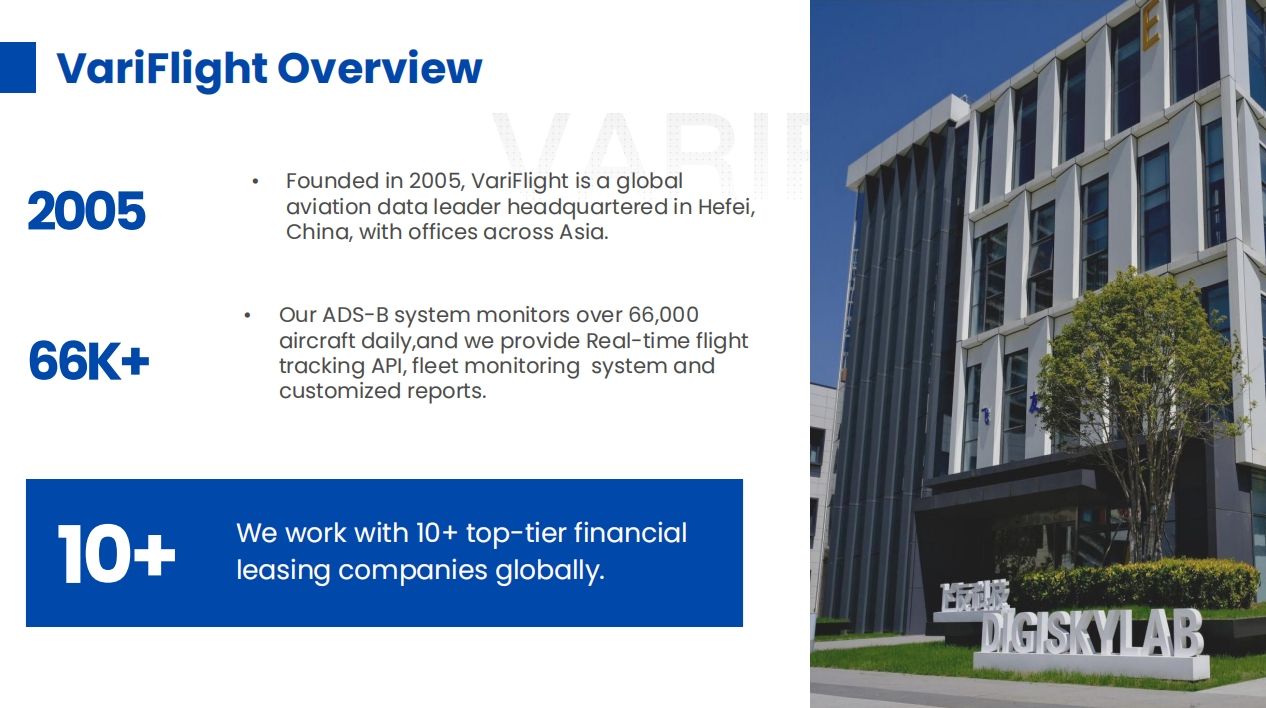
VariFlight’s integrated asset monitoring platform offers comprehensive, real-time insight into aircraft location, working status, flight behavior, and lessee activity. Lessors can track important details of their assets. They use data from ADS-B receivers, flight records, and system alerts. You can do this from anywhere in the world.
Why do lessors need a real-time management solution?
Traditional aircraft leasing models often depend on reports from lessees. These reports may experience delays, have poor formatting, and lack making things the same. This results in several key problems:
Delayed identification of irregular operations
Inconsistent data reporting
Limited visibility during lease periods
Increased risk in asset valuation and credit exposure
A robust aircraft monitoring solution bridges this gap by providing:
* Immediate awareness of flight events and status
* Structured data for accurate technical and financial assessments
* Centralized control over distributed fleets
* Early warnings for working or about world politics risk
According to [IATA], Leasing companies hold over 50% of the global commercial fleet, highlighting the scale of the challenge.
How does dynamic management compare to static asset management?
Traditional asset oversight models rely heavily on **static monitoring** — quarterly reports, manual audits, and fragmented spreadsheets. This method may work for low-risk assets or old systems. However, it does not meet the needs of a rapidly changing aviation environment.
Static Monitoring Limitations:
* Data is outdated by the time it's reviewed
* No live alerting for unusual behaviors
* Inflexible formats reduce ability to compare
* High dependency on lessee cooperation
Dynamic Monitoring Advantages:
Real-time flight and status tracking
Automated alerts for high-risk activity
Centralized dashboards for large fleets
Reliable basis for credit assessment and asset valuation
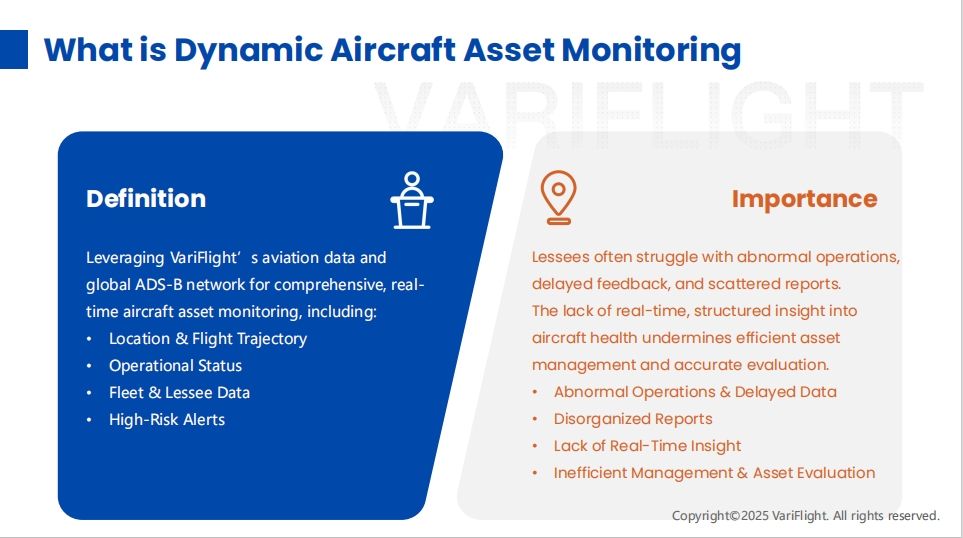
Dynamic monitoring helps lessors. It allows them to respond to new risks. It also ensures contract compliance. Additionally, it increases fleet value more effectively than static reports.
What types of data does aircraft asset management include?
Modern aircraft monitoring platforms, like the one from VariFlight, provide a lot of data. This helps lessors fully monitor aircraft operations. The key data components include:
Aircraft Location and Flight Trajectory: Monitor live position, route history, and real-time movements. Track whether an aircraft enters sanctioned regions or operates outside its contracted range.
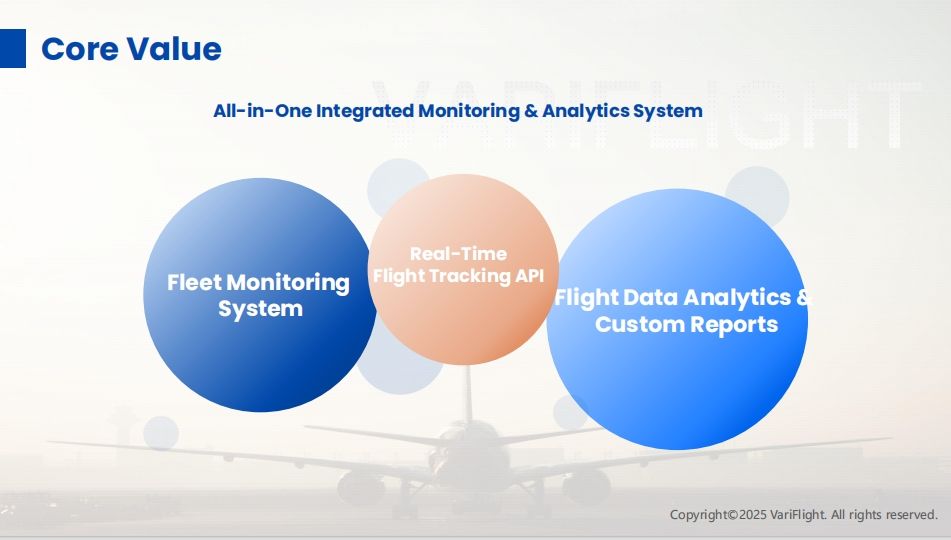
Working Status: Determine whether the aircraft is active, grounded, or stored for long periods. Quickly detect unusual downtimes or unscheduled diversions.
Flight Cycles and Utilization Metrics: Assess usage intensity, engine life, and compliance with maintenance schedules. Vital for residual value calculations.
Lessee Working Behavior:Compare operating patterns across lessees. Identify risky operators or doing poorly relative to fleet benchmarks.
Alerts and Risk Indicators: Automated triggers detect inactivity, entry into restricted zones, or deviations from normal flight behavior.
What are the key modules in VariFlight’s aircraft management platform?
VariFlight’s platform is structured around four main modules:
Aircraft Profile Module:Stores metadata such as manufacturer, age, registration, delivery date, engine configuration, and leasing structure.
Working Metrics Module: Provides detailed metrics on flight hours, cycles, utilization rate, airport patterns, and long-term parking.
Alerts and Notification Module: Notifies stakeholders about important issues like long groundings or entering high-risk airspace [ICAO Safety Map]
Fleet and Lessee Analysis Module: Enables macro-level insights by aggregating performance by lessee, region, aircraft type, and status breakdown.
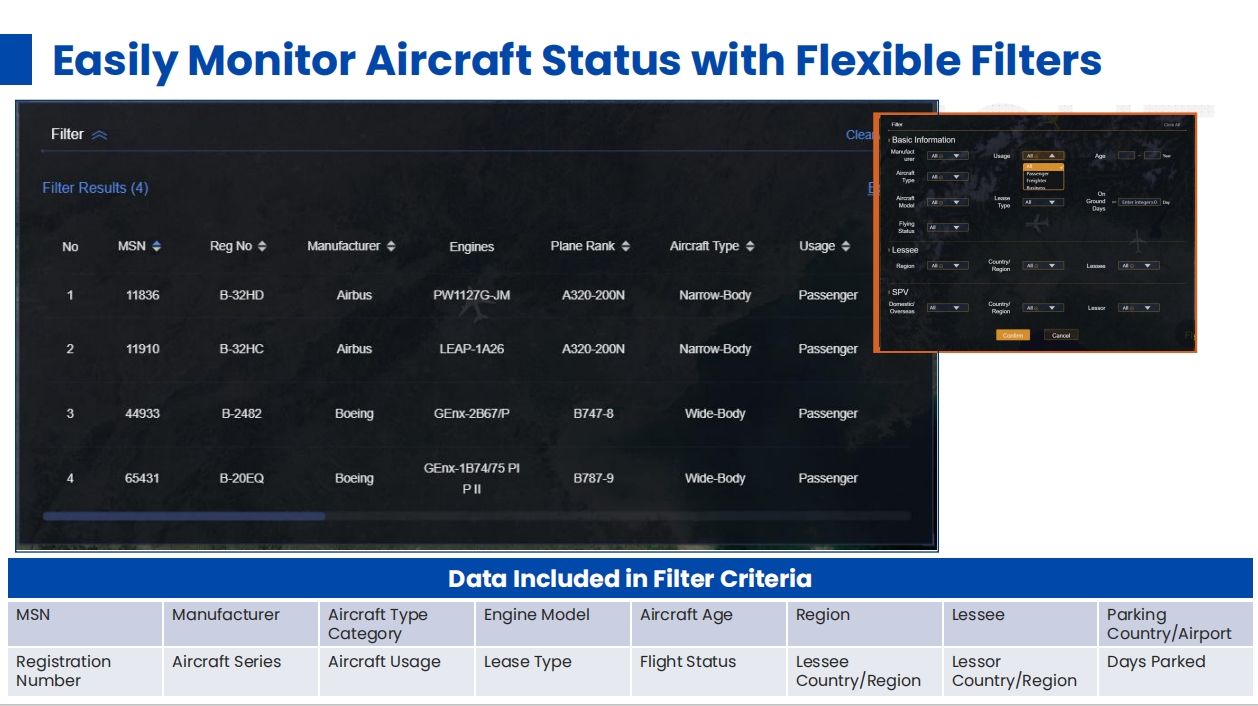
What are the benefits of using VariFlight’s management solution?
Using a dynamic aircraft monitoring solution results in measurable benefits:
Real-Time Risk Control:Detect aircraft entering conflict zones or parked for too long.
Enhanced Asset Visibility:Track global fleets in a single dashboard, updated in real time.
Improved Lessee Transparency:Replace static reports with verified operational data streams.
Smarter Maintenance Planning:Utilization-based alerts ensure proactive MRO scheduling.
Reduced Credit Risk:Cross-reference lessee behavior with default or payment risk profiles.
Increased Asset Value:Protect aircraft value by managing downtime and wear proactively.
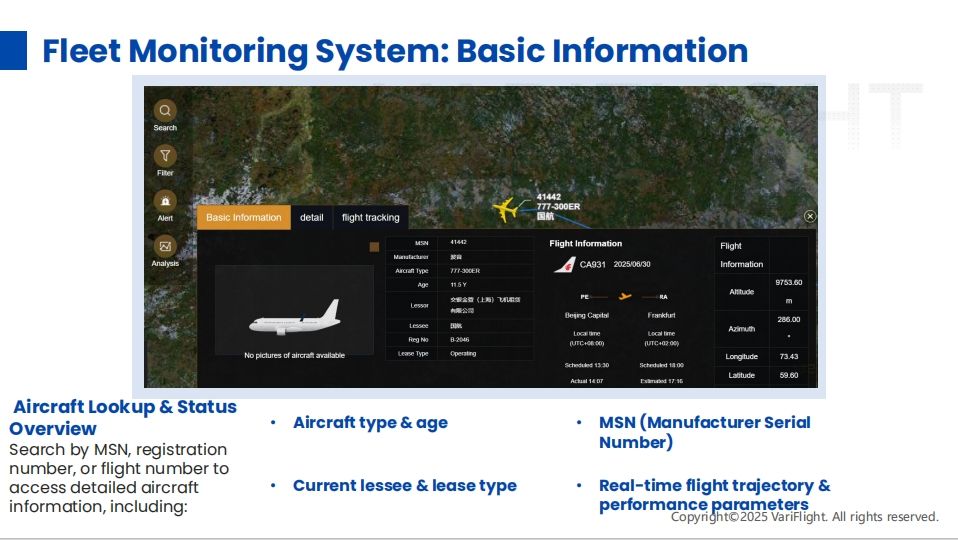
How does DataWorks support aircraft asset management?
DataWorks is VariFlight’s cloud-based aviation analytics platform. It brings together real-time ADS-B data, performance monitoring, and intelligent alerting for aircraft lessors.
Key functions include:
Global ADS-B flight tracking
Live dashboards on fleet utilization
Automated alerts for irregular operations
Customizable reports for audit or compliance
Secure, scalable access for teams of all sizes
Built for lessors, MROs, and asset managers, DataWorks bridges the gap between flight data and financial decision-making.
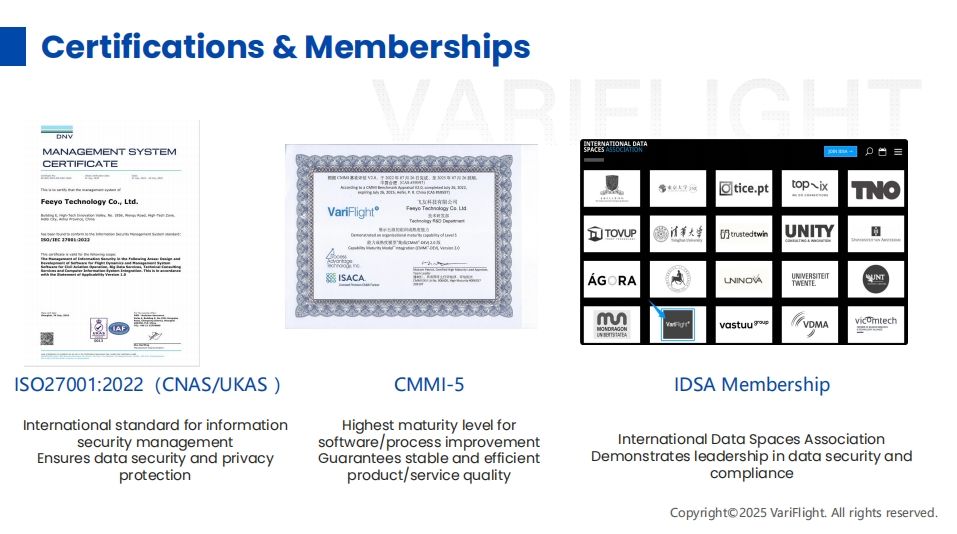
As we continue to enhance our global solutions, our commitment to data security, operational excellence, and compliance remains unwavering. VariFlight is certified with ISO/IEC 27001:2022 (CNAS/UKAS) — the international standard for information security management, ensuring robust data protection and privacy. We have also achieved CMMI Level 5, the highest maturity level for software and process improvement, which guarantees consistent, efficient, and high-quality service delivery. Additionally, as a member of the International Data Spaces Association (IDSA), we demonstrate our leadership in secure, compliant, and trustworthy data ecosystems. These certifications reflect our long-term dedication to building reliable infrastructure and providing peace of mind for partners worldwide.
Who is already using this technology?
VariFlight works with 10+ top-tier financial leasing companies globally including ICBC Leasing — a major player with extensive experience and a large aircraft asset portfolio.
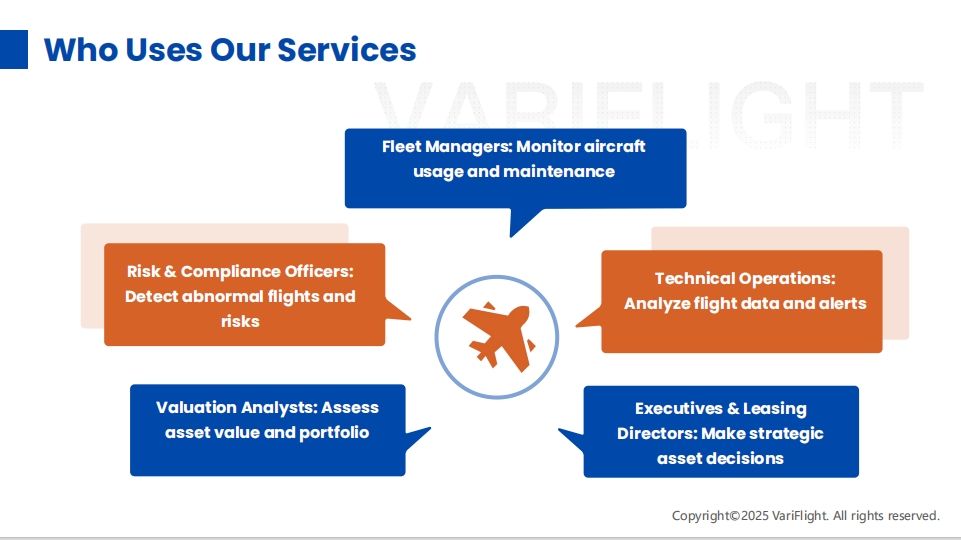
According to [Statista], the global commercial aircraft fleet will surpass 39,000 units by 2033, amplifying the need for automated, intelligent monitoring solutions.
How can I start?
If you’re ready to take control of your aircraft assets and move beyond spreadsheets, the team at VariFlight is here to help. Whether you manage 10 aircraft or 1,000, we can scale with your needs. Contact us to set up a demo of the DataWorks platform. See how real-time monitoring can lower risk, improve operations, and increase ROI.
